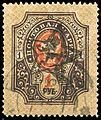Transcaucasian SFSR facts for kids
The Transcaucasian SFSR was a special group of countries that were part of the Soviet Union. It included what we now know as Georgia, Armenia, and Azerbaijan. Its main city, or capital, was Tbilisi. This union lasted for about 14 years, from 1922 to 1936.
Contents
What Was the Transcaucasian SFSR?
The Transcaucasian SFSR stands for the Transcaucasian Soviet Federative Socialist Republic. It was one of the first parts of the Soviet Union when it was created in 1922. Think of it as a big region made up of three smaller countries working together under the Soviet government.
Where Was It Located?
This republic was located in a region called Transcaucasia. This area is between the Black Sea and the Caspian Sea, in the Caucasus Mountains. Today, this region is home to the independent countries of Georgia, Armenia, and Azerbaijan.
When Did It Exist?
The Transcaucasian SFSR was formed on December 13, 1922. It was a very important time because it joined the larger Soviet Union just a few weeks later, on December 30, 1922. It continued to exist until December 5, 1936. At that point, the three parts – Georgia, Armenia, and Azerbaijan – became separate republics within the Soviet Union.
Images for kids
See also
 In Spanish: República Socialista Federativa Soviética de Transcaucasia para niños
In Spanish: República Socialista Federativa Soviética de Transcaucasia para niños





